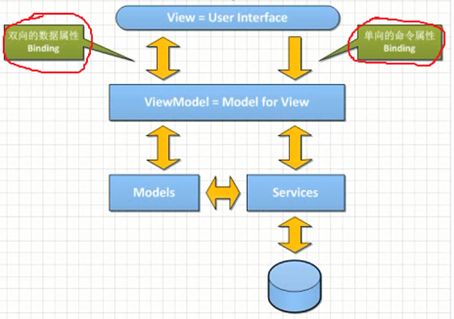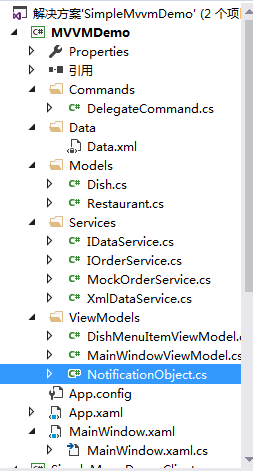一 学习前提:
(1)Data Binding
(2)Dependency Property
(3)委托、事件、命令ICommand
上面三点内容,在学习MVVM之前要求简单了解并掌握使用。
MVVM介绍
MVC,Model - View - Controller的模式,页面和代码分离的写法,MVVM:Model - View - ViewModel,和WPF很好的进行结合,View负责界面,主要是写.xaml的文件,Model是一些实体类;ViewModel是联系两者的关键,并分离两者;
View需要什么,ViewModel就提供什么,如果将View理解为界面,Model和ViewModel以及Service等理解为后台的话,那么界面和后台是没有任何关系的,界面开发人员只要告诉后台人员需要哪些对象/属性,就可以进行开发了,二者之间的结合通过Binding操作进行绑定,解耦效果优于MVC,架构图如下:

几个重要的概念:
1、属性
1)数据绑定源:CLR对象、动态对象、ADO.NET 对象、XML对象、DependencyObject对象
2)命令属性:ICommand、
3) 集合对象绑定:ObservableCollection
2、NotificationObject类
3、ICommand接口
MVVM的难点和重点在于View以及MiewModel之间的绑定。三 项目实战
效果如下:
按照上述架构图新建目录如下:
按照从底层到显示层的策略:
(1)Data
土豆泥底披萨
披萨
本店特色
4.5
烤囊底披萨
披萨
本店特色
5
水果披萨
披萨
4
牛肉披萨
披萨
5
(2)Model
//定义Model,用于和xml文档中的节点属性匹配
class Dish
{
public string Name { get; set; }
public string Category { get; set; }
public string Comment { get; set; }
public double Score { get; set; }
}class Restaurant
{
public string Name { get; set; }
public string Address { get; set; }
public string PhoneNumber { get; set; }
}(3)Service
接口:
interface IDataService
{
List GetAllDishes();
} interface IOrderService
{
void PlaceOrder(List dishes);
} 实现:
class XmlDataService:IDataService
{
public List GetAllDishes()
{
//读取Dish集合,用于接收数据并返回值
List dishList = new List();
//读取XML文件路径
string xmlFileName = System.IO.Path.Combine(Environment.CurrentDirectory, @"Data\Data.xml");
//加载xml文件
XDocument xDoc = XDocument.Load(xmlFileName);
//按照顺序返回集合下标签里的所有内容
var dishes = xDoc.Descendants("Dish");
//将xml筛选的集合里的属性与Model对象绑定
foreach (var d in dishes)
{
Dish dish = new Dish();
dish.Name = d.Element("Name").Value;
dish.Category = d.Element("Category").Value;
dish.Comment = d.Element("Comment").Value;
dish.Score = double.Parse(d.Element("Score").Value);
//添加到List集合
dishList.Add(dish);
}
return dishList;
}
} class MockOrderService:IOrderService
{
public void PlaceOrder(List dishes)
{
System.IO.File.WriteAllLines(@"C:\order.txt", dishes.ToArray());
}
} 至此,静态的代码编写完毕,无论是使用什么类型的框架,这部分东西大同小异。
(4)ViewModels
class DishMenuItemViewModel:NotificationObject
{
public Dish Dish { get; set; }
//将IsSelected属性和Dish中的属性一起作为DishMenuItemViewModel里的属性
private bool isSelected;
public bool IsSelected
{
get { return isSelected; }
set
{
//RaisePropertyChanged方法,源于引入属性更改通知类
isSelected = value;
this.RaisePropertyChanged("IsSeleted");//"IsSelected"属性值变化之后,自动通知使用该属性的方法,有点观察者模式的意思
}
}
}class MainWindowViewModel : NotificationObject
{
public DelegateCommand PlaceOrderCommand { get; set; }
public DelegateCommand SelectMenuItemCommand { get; set; }
public DelegateCommand RemoveItemCommand { get; set; }
private double count;
//数据属性-Count
public double Count
{
get { return count; }
set
{
count = value;
this.RaisePropertyChanged("Count");
}
}
private Restaurant restaurant;
//数据属性-Restaurant
public Restaurant Restaurant
{
get { return restaurant; }
set
{
restaurant = value;
this.RaisePropertyChanged("Restaurant");
}
}
private ObservableCollection dishMenu;
public ObservableCollection DishMenu
{
get { return dishMenu; }
set
{
dishMenu = value;
this.RaisePropertyChanged("DishMenu");
}
}
public MainWindowViewModel()
{
this.LoadRestaurant();
this.LoadDishMenu();
//单向"命令属性"的加载过程,通过实例化委托的形式
this.PlaceOrderCommand = new DelegateCommand();
this.PlaceOrderCommand.ExecuteAction = new Action 其中DelegateCommand就是继承ICommand而来,包括二个方法和一个事件:
class DelegateCommand : ICommand
{
public bool CanExecute(object parameter)
{
if (this.CanExecuteFunc == null)
{
return true;
}
return this.CanExecuteFunc(parameter);
}
public event EventHandler CanExecuteChanged;
public void Execute(object parameter)
{
if (this.ExecuteAction == null)
{
return;
}
this.ExecuteAction(parameter);
}
public Action ExecuteAction { get; set; }
public Func CanExecuteFunc { get; set; }
} 其实会发现,在ViewModel当中并没有很强的业务逻辑,业务逻辑更多的是放到Service当中的,在ViewModel当中所存放的内容,更多的会是一些属性,包括命令属性、数据属性,这些用于和View进行绑定,通过Binding,发现,后台的数据改变了,直接就会在前台页面上更新,这就是MVVM + WPF的魅力之一。同时也要知道,View和ViewModel之间的绑定,也是使用这个框架的难点之一。
(5)View
通过对控件的属性、样式进行设置.
通过Binding和后台数据进行绑定.
订餐系统:
此时会发现,在View的.cs代码里,没有类似于onClick(),这样的方法,都通过绑定实现自动更新了。
(6)设置View的数据来源
public MainWindow()
{
InitializeComponent();
this.DataContext = new MainWindowViewModel();
}在View的.cs文件中,通过this.DataContext = new MainWindowViewModel();的方式,绑定该View的数据来自于哪个ViewModel。
ps:另外,主要参考文章http://blog.csdn.net/zzh92062...
我做了代码演示并进行一些扩展,主要在于把List
至此,MVVM框架的简单实用,就通过这个例子实现了。
That's all.